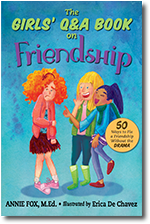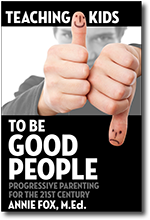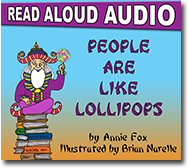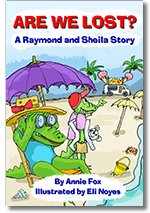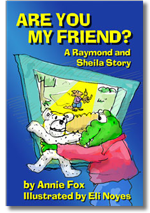|
|
December 20, 2014
T’is the season for parties. When it’s a family affair, all the kids are included. But as you get older, you may want to organize your own get-togethers, and that means only “special friends” get invited. If you’ve been left off a party invitation list you might have felt left-out. But what if you were invited to a party and one of your besties wasn’t? Awkward situation!
This question comes from a girl who found herself in that situation. Her question and my answer are included in my latest book, The Girls’ Q&A Book on Friendship: 50 Ways to Fix a Friendship Without the DRAMA. Read on…
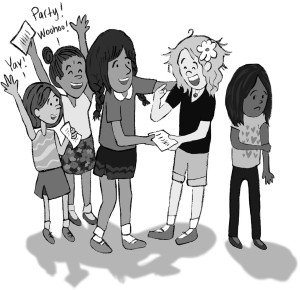 “I got invited, but my friend didn’t! Awkward!”
Q: “Friend A invited everyone to her party except Friend B. Now Friend B is mad at me for wanting to go. But I need to go so I can be popular. Is it worth it?”
Answer: If understand that you want to go to the party, but if everyone was invited except Friend B, you can understand why she is upset. Maybe you can also understand why she is angry that you want to go without her.
When you say, “I need to go to the party so I can be popular,” I wonder if the Popularity Game means more to you than Friend B. People who ditch friends to be with more “popular” people often find themselves without any real friends.
Should you go to the party? Good question! If you do, then Friend B will probably be unhappy with you. She might get over it, but there is also a chance that your going to the party could really damage the friendship. You are the only one who can decide if it’s “worth the risk. To help you figure it out, think about this: If Friend B go invited and you didn’t, how would you feel about her going with you? If it wouldn’t feel right for her to go, then it’s probably not right for you.
_______
If you’re curious about the 49 other questions and answers in The Girls Q&A Book on Friendship, check out this free excerpt. If you’ve got a friendship challenge you need help with right now, email me or post it to the comments below.
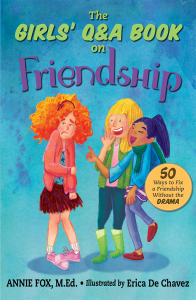 50 Ways to Fix a Friendship without the DRAMA

December 17, 2013
Excerpted from my book, Teaching Kids to Be Good People.
 A no-tech solution to connection addiction While we’re all moving in ten directions at once, online and off, the notion of evenings and weekends where parents and kids spend unplugged time together is laughably retro. But life is neither virtual nor infinite. We’ve got to create an antidote to 21st century craziness otherwise our kids will grow up without us really knowing them and without them knowing us.
Listening (the old- fashioned way) with open eyes, mind, and heart is the best way we connect with our kids, and teach them how to connect with others. That’s what we want from them and for them. They need it now while they’re still learning about healthy relationships from us, so they can use it later when they’re creating intimate relationships of their own.
How do we teach them that the people we care about aren’t just on Facebook and Twitter, they’re right here in the real world and they deserve our attention?
Fuel for Thought—Think about a relationship you have where the other person is often “distracted.” What’s it like being with him/her? Contrast that with someone who is normally “there” with you. Now think about the level of “there-ness” you give to your family. Set a goal for the next week: Do a better job being with your family when you’re actually with them. Do not allow distractions to get in the way. Observe what happens.
Conversations That Count—Talk with your partner and child(ten) about digital distractions, including phones, games, TV shows, and computers. Ask them to rate the family (on a 1–10 scale) regarding the presence of distractions while people are talking to each other.
(Scoring scale: 1 = When we talk to each other, we’re not doing anything else; 10 = When we talk to each other there’s always a “distraction” present.)
Your 21st century child may not even have noticed or considered these “distractions” as anything other than “normal.” Ask what s/he thinks family life (vis-à-vis “distractions”) might look like when s/he’s grown up with their own family.
Teach—Create an Unplugging Challenge. Start small and doable. For example, “On Saturday from 4:00–5:00 p.m. we’re unplugging for an hour to do something fun, together, as a family.” Be ready for pushback from tweens/teens. Remind them it’s only for one hour. “Surely you guys can last 60 minutes w/o FB?!” “Yeah, of course we can, but we don’t want to!!!” The more resistance, the more likely your kids have a connection addiction. But don’t cave. Be upbeat. Take suggestions for a non-tech activity the family can do together for that short time. Play a board game, card game, make popcorn, build something, cook something, bake something, create something, take a walk, go for a bike ride, have an impromptu meal outside, read aloud from a mystery book, look at old family photos and tell stories. Etc. etc. Be together. Focus on each other. Have fun. Repeat often. Appreciate being a family. It’s the best gift there is during any season.

December 13, 2013
 We’re here to help, not judge Man, it’s been beyond chilly in California. (Mid-westerners, no snide chuckles, please. I don’t care what your definition of winter is, 23 degrees is cold.) But still, I’m into this. I love watching the dogs romping in the 5 pm sunset over at the park. I love making soup and lighting candles in my living room now packed with plants wintering inside. I love how business meetings get pushed off til January and that most people are down-shifting to a family-oriented gear. With our first grandchild on the way, I’m thinking more about the chain of love, life and the power we have, generation to generation… to teach kids to be kind, compassionate and open-minded. To help you do that, here’s an excerpt from my parenting book, Teaching Kids to Be Good People.
We assume we know so much more about other folks than we actually do. Teaching kids to be good people includes helping them understand how biases get in the way of knowing who people really are, what they need, and how we can help them (because that’s what we’re here for.)
From the We’re on This Speck Together file comes some food for thought from Carl Sagan: “For small creatures such as we, the vastness is bearable only through love.” Think back to middle or high school. What did your peers assume about you that wasn’t true? How do imagine those assumptions affected people’s relationships with you? Think about a former classmate who had a certain “reputation” which led you to have certain assumptions about him/her. How did your assumptions color your behavior toward that person?
• Talk with your child(ren) about the concept of the “judge” within us who rates other people mostly in terms of what we like/admire about them and what we don’t. Discuss how unfair it can feel to be judged, especially when the “judges” don’t really know us.
• Make a pledge to monitor your “judgmental” thoughts more carefully between now and New Year’s Day. Try to catch those critical thoughts before they become words. Each time we let The Judge put someone down, we stack another brick in the wall of misunderstanding. With less judging, we get to know each other better. Let’s teach kids to build bridges, not walls.

December 11, 2013
I originally wrote a version of this essay back in ’05 BT (before Twitter). People have requested a reprint. Here you go. Enjoy… in joy.
The year our daughter Fayette turned 15 she said she didn’t want us to buy her “stuff” for Hanukkah. Huh? What was going on? Didn’t she still love us? Wasn’t she grateful for the many carefully selected gifts she’d received since… birth? Was she running away and needing to travel light?!
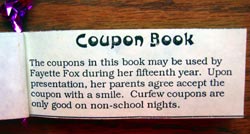 Get creative with those coupons The truth was less sinister and more profoundly personal. As she put it, “I’ve had it with holiday commercialism.” This led to a lively family discussion about Needs vs. Desires. Form vs. Substance. Carnivores vs. Vegetarians.
NOTE1: Our son Ezra was then 9 and while he dearly loved and coveted all kinds of “stuff,” (except when it came to clearing it off the floor) he agreed his sister’s idea merited serious philosophical consideration.
NOTE2: Ezra now holds an undergraduate degree in philosophy.
Despite a holiday moratorium on buying stuff there were no restrictions on loving acts of giving. So we each faced the creative challenge of figuring out what to give. That first year we abandoned traditional gift-giving our tokens of affection and admiration became more experiential and far-reaching. There were live performances and other cultural outings, food factory tours, waterfall hikes, baked desserts, multi-media presentations, and hand-crafted treasures. But the best innovation was the advent of personalized coupons books, i.e., hand-made packets offering a variety of customized “goods, services and special privileges.” The key to coupon success is knowing your recipient.
Fayette, who frequently got busted for talking on the phone after lights out, was thrilled to get: “This coupon entitles you to use the phone between 11-11:30 on a school night. Homework and all getting ready for bed preparations must first be completed.”
Ezra, who has always loved sweets, got: “This coupon entitles you to 2 dozen of your choice of home-made cookies that you don’t have to share with anyone (unless you happen to be feeling particularly generous). Minimum 24 hour notice required.”
 "Goldfish Tea" by Fayette Fox I remember happily receiving: “I will water all the plants in the house for you for 1 week.” And David, who spends lots of time hunched over his computer keyboard, was delighted to get: “I will give you a 10 minute shoulder massage.”
Just to be clear, I’m not proposing a “No Buy” Zone. We’re emerging from tough economic times and retailers (large and small) are hoping we’ve regained enough confidence in our future earning power to do our part for the recovery. The Don’t Buy Me Any Stuff” Gift Guide is not an all or nothing deal. Let’s face, there is very cool stuff in stores. And sometimes the special something your kid craves is just what you want to give, and if you can, go for it. Then knock yourself out on the kid’s joy when he/she receives your gift. All I’m saying is that you are not and never have been required to go into debt buying stuff that’s out of synch with your innate sense of what’s appropriate and healthy for your child.
So, if you’re looking for extra meaning this holiday season and a little less wear and tear on your family values, talk to your kids about alternatives to traditional gift-giving. It may not be coupons, but your family will likely come up with all kinds of great ideas. When we explore more creative ways to show our love for each other, we celebrate the uniqueness of each of family member. Now there’s a gift!
 Happy holidays from our family to yours
 — Older Posts »
| |











